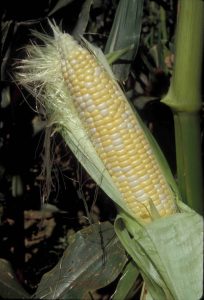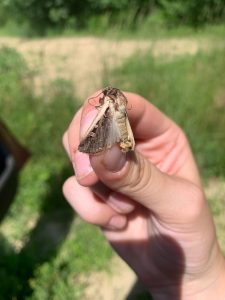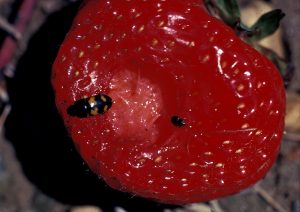Sweet Corn IPM Newsletter No. 7 – August 26, 2019

Sweet Corn IPM Newsletter No. 7 – August 26, 2019
Click on photos to enlarge.
CORN EARWORM PRESSURE REMAINS HIGH
Moth Activity Down Slightly, But Still a Threat to Silking Corn
SITUATION
Recent very warm days and nights have pushed maturity of later planted corn. Showers have kept most fields from experiencing drought stress, so overall quality continues to be good. The weather has also allowed insect pressure to remain high. Silking corn is especially at risk due to high numbers of corn earworm throughout the state.
European corn borer: Moth activity remains low with only one farm in Garland over the five moth per week threshold for silking corn. Most locations caught no moths. Feeding injury by larvae on pre-tassel corn was also low, with no fields exceeding the 15% control threshold.
Corn earworm: Moth captures decreased slightly or remained stable at most locations this week, but populations are still high enough to threaten any fresh silking corn. A six-day spray interval for silking corn was recommended in Palmyra this week. A five-day spray interval was recommended for silking fields in Levant, Monmouth and Nobleboro. A four-day spray schedule was recommended in Auburn, Biddeford, Bowdoinham, Cape Elizabeth, Charleston, Dayton, Garland, Lewiston, Poland Spring, Sabattus, Wayne and one Wells site.

Fall armyworm: Moth counts were over the 3-moth threshold for silking corn in Bowdoinham, Cape Elizabeth, Lewiston, Monmouth, Poland Spring, Wayne and one Wells site; but all sites were also under a spray interval for corn earworm, so no additional controls should be needed. Larval feeding damage was over the 15% spray threshold at one Cape Elizabeth site this week.
Western bean cutworm: Moth counts remain high at nearly all trapping locations this week, exceeding the suggested three moth per week threshold for silking corn. Sprays applied to silking corn for corn earworm should also protect against western bean cutworm. Sprays for western bean cutworm on silking corn were recommended in Oxford and Farmington where corn earworm counts were below threshold.
Squash vine borer: Moth counts remained low this week. No fields were above the threshold of 5 moths.
Picnic beetles can become a problem during the late summer on silking corn. These beetles are about 1/4-inch long, black with orange spots. They can often be found on stalks and ears that are infested with European corn borer or fall armyworm, feeding on sap at an entry or exit hole. They will also feed on the silks and may work their way into the silk channel. While the damage is usually insignificant, customers dislike finding the insects in their bags. Sprays to control corn earworm should provide control of these beetles if they are found in your field.
- Picnic Beetle (left) on strawberry and Strawberry Sap Beetle (right); photo by James Dill
- Bird Damage on Corn; photo by David Handley
Birds: Blackbirds have been damaging cornfields in recent days. They are especially attracted to fields where corn has been allowed to get over-mature. For information on wildlife problems and management options, you can call the Animal and Plant Health Inspection Service office in Augusta at 1.866.487.3297.
Sincerely,
David T. Handley
Vegetable and Small Fruit Specialist
Highmoor Farm UMaine Extension Diagnostic
P.O. Box 179 Research Lab, Pest Mgmt. Unit
52 U.S. Route 202 17 Godfrey Drive
Monmouth, ME 04259 Orono, ME 04473
207.933.2100 1.800.287.0279
Sweet Corn IPM Weekly Scouting Summary
| Location | CEW Moths |
ECB Moths |
FAW Moths |
WBC Moths |
Feeding Damage |
Recommendations / Comments |
|---|---|---|---|---|---|---|
| Auburn | 14 | 0 | 0 | 12 | 4-day spray interval for all silking corn | |
| Biddeford | 25 | 0 | 1 | 5 | 0% | 4-day spray interval for silking corn |
| Bowdoinham | 9 | 0 | 6 | 11 | 14% | 4-day spray interval for all silking corn |
| Cape Elizabeth I | 20 | 1 | 5 | 6 | 30% | 4-day spray interval for silking corn |
| Cape Elizabeth II | 33 | 3 | 0 | 9 | 4-day spray interval for silking corn | |
| Charleston | 10 | 3 | 0 | 0% | 4-day spray interval for all silking corn | |
| Dayton I | 72 | 0 | 1 | 31 | 4-day spray interval for silking corn | |
| Dayton II | 67 | 1 | 1 | 22 | 1% | 4-day spray interval for silking corn |
| Farmington | 1 | 1 | 0 | 30 | 1 spray for WBC on silking corn, | |
| Garland | 11 | 5 | 0 | 4-day spray interval for all silking corn | ||
| Lewiston | 41 | 1 | 5 | 18 | 4-day spray interval for all silking corn | |
| Levant | 4 | 0 | 0 | 5-day spray interval for all silking corn | ||
| Monmouth | 5 | 0 | 4 | 11 | 5-day spray interval for all silking corn | |
| Nobleboro | 4 | 0 | 0 | 66 | 7% | 5-day spray interval for all silking corn |
| Oxford | 0 | 0 | 1 | 30 | 0% | 1 spray for WBC on silking corn, |
| Palmyra | 2 | 0 | 0 | 6-day spray interval for all silking corn | ||
| Poland Spring | 11 | 0 | 2 | 67 | 4-day spray interval for all silking corn | |
| Sabattus | 15 | 0 | 0 | 9 | 4-day spray interval for all silking corn | |
| Wayne | 10 | 0 | 3 | 3 | 12% | 4-day spray interval for all silking corn |
| Wells I | 0 | 0 | 0 | 0 | No spray recommended | |
| Wells II | 25 | 0 | 4 | 8 | 9% | 4-day spray interval for all silking corn |
CEW: Corn earworm (Only fresh silking corn should be sprayed for this insect.)
ECB: European corn borer
FAW: Fall armyworm
WBC: Western bean cutworm
Corn Earworm Spray Thresholds for Pheromone Traps
| Moths caught per week | Moths caught per night | Spray interval |
|---|---|---|
| 0.0 to 1.4 | 0.0 to 0.2 | No spray |
| 1.5 to 3.5 | 0.3 to 0.5 | Spray every 6 days |
| 3.6 to 7.0 | 0.6 to 1.0 | Spray every 5 days |
| 7.1 to 91 | 1.1 to 13.0 | Spray every 4 days |
| More than 91 | More than 13 | Spray every 3 days |
Thresholds apply only to corn with exposed fresh silk. Lengthen spray intervals by one day if maximum daily temperature is less than 80°F.
European Corn Borer Thresholds
Whorl stage: 30% or more of plants scouted show injury.
Pre-tassel-silk: 15% or more of plants scouted show injury.
Silk: 5 or more moths caught in pheromone traps in one week.
IPM Web Pages:
UMaine Cooperative Extension Integrated Pest Management
Penn State Pest Watch – Sweet Corn
UMass Amherst Integrated Pest Management
Where brand names or company names are used, it is for the reader’s information. No endorsement is implied nor is any discrimination intended against other products with similar ingredients. Always consult product labels for rates, application instructions and safety precautions. Users of these products assume all associated risks.
The University of Maine is an equal opportunity/affirmative action institution.


